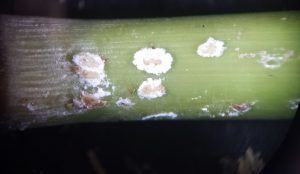May 1, 2017
The following is a summary of notes made by Great Lakes Commission staff while viewing the webinar “Roseau cane in Louisiana,” presented by Louisiana State University researchers on April 27th.These notes are provided as a summary of key points from a Great Lakes perspective. Note that this following summary is intended as an overview only – viewing the recorded webinar is highly recommended for full details. We will continue to monitor this story and will provide updates here and on our Phragmites listserv as they emerge.
Webinar Description
 In fall 2016, the scale Nipponaclerda biwakoensis (Kuwana) (Hemiptera: Aclerdidae) was discovered attacking Phragmites (roseau cane) in Plaquemines Parish. The native range of this scale includes China and Japan. The objectives of the webinar will be to describe the problem, present current knowledge on the biology and ecology of the scale, and propose short and long term management options.
In fall 2016, the scale Nipponaclerda biwakoensis (Kuwana) (Hemiptera: Aclerdidae) was discovered attacking Phragmites (roseau cane) in Plaquemines Parish. The native range of this scale includes China and Japan. The objectives of the webinar will be to describe the problem, present current knowledge on the biology and ecology of the scale, and propose short and long term management options.
Presenters: Drs. Jim Cronin, Blake Wilson and Rodrigo Diaz, LSU Dept. of Entomology
Summary of Key Points from the Webinar
Background
- Populations of Phragmites australis in coastal Louisiana (locally known as Roseau cane) appeared to crash over the winter of 2016-17; it is not entirely clear how these population(s) relate to Great Lakes Phragmites, but they are genetically similar
- A recently confirmed scale insect has been identified as the cause of the population crash
- Phragmites/Roseau cane is perceived as an important species for coastal resilience and shoreline stabilization along the Gulf Coast, which is why news articles about this insect report that it is ‘decimating’ coastal stands of Phragmites
Note that the following summary is intended as an overview only – viewing the recorded webinar is highly recommended for full details.
Key points of interest from a Great Lakes perspective:
Gulf Coast Phragmites genetic diversity:
- High genetic diversity of Phargmites along Gulf Coast with at least 4 lineages
- Hybridization between these lineages is occurring, and these lineages occur in mixed patches at the same sites
- The scale insect has been confirmed to occur on the Gulf, Delta, and Greeny lineages, but is believed that it is likely found on the European (Great Lakes) lineage also
- These lineages differ substantially in their resistance to herbivory
Gulf Coast Phragmites known lineages:
- Gulf lineage:
- Debate on whether it is native or non-native, but it has occurred in the state for at least 100 years
- Believed to be the most spatially distributed Phragmites type in the state, though this could be due to sampling effects
- Branching stems that are reddish and woody
- European lineage:
- Invasive strain common in the Great Lakes region and east coast
- Purple panicles
- Delta lineage:
- Believed to be the most dominant variety in the region
- African origin
- Tall with often hairy leaves
- Greeny lineage:
- Unknown history
- European origin
- Appears greener in color than other varieties
Gulf Coast Phragmites-preying scale Insect:
- Feeds on xylem and phloem
- Overwinters
- Very tiny and highly mobile
- Proceeds through several life stages on the plant –eggs, larval stage, adult stage
- Density in 2016: 6 foot stalk could have 70-189 individual insects or as many as 728; median of 9.6 scales per 10 inches
- Scale predates on other species also – e.g. wheatgrass, rush
- Short distance dispersal – crawlers move to neighboring plants
- Long distance dispersal – boats, humans, birds (grackle and red-wing blackbird are associated), wind, floating stems
- Native range of scale occurs in colder regions – china, japan; Louisiana has longer growing season, may result in population effects
- Is usually found above the water level but has been observed surviving below water in china for several days
- It is not yet known whether this scale insect could survive overwintering in the Great Lakes region
- Unclear if this scale is a threat to agricultural crops (sorghum, corn)
Prevention/Control Options:
- Wash boats after contact with Roseau to prevent spread of scale
- Burning control: winter burning is the best approach in stands with dense regrowth
- Roseau pests in China are controlled by burning
- Location of oil and gas wells in LA limits ability to burn
- Herbicide control: scales are common agricultural pests controlled by herbicide but the wetland element makes herbicide use more sensitive
- Many insecticides have negative effects on shrimp
- Wicking is likely the safest application method
- Biocontrol:
- Ants often predate scales but have not been observed on Roseau
- A tiny predatory wasp has been attacking the scale:
- Wasp is a non-native species already present in the US
- Wasp larval stage occurs inside of scale host; when the stem is dissected, can recognize wasp larvae inside the female scale
- The wasp is endemic to Japan
- In some cases, 80% of scales were parasitized by wasp
- Will study parasitic wasp as a bio-control option – note that this species has already been introduced into the US (we assume that this introduction was accidental)
